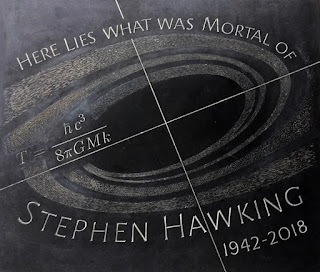Quilt No. 129
January 2019
"Remember to look up at the stars and not down at your feet. Try to make sense of what you see and wonder about what makes the universe exist. Be curious. And however difficult life may seem, there is always something you can do and succeed at. It matters that you don’t just give up." Stephen Hawking (1942-2018)
Stephen Hawking’s words bring us not only wisdom but
comfort. I thought of them many times as
I worked through this quilt. “It matters
that you don’t just give up”. I’m pretty
sure Mr. Hawking wasn’t thinking about quilting when he said those words! More than once they kept me from throwing the
unfinished quilt and the torn-out remnants of my hair into the dumpster. As I chugged along for ten months, there were many technical issues that made me want to just give up.
How to capture a life lived in a wheelchair but not defined by a wheelchair? How to keep the delicate
organza layers from shredding? How to get white text onto dark fabric? How and what to quilt on the borders? How to keep the differentially quilted
surface flat? How to keep plugging away after the tedium of the first several hundred
beads had not only drained my patience but set my teeth on edge? All this had to be resolved. And every bit of it was infinitely trivial in
comparison to what Hawking would have faced each day of his adult life.
Diagnosed with ALS in his early twenties, and given a
prognosis of only a few years of survival, Hawking somehow conquered
the odds. He not only lived into his mid-seventies,
he managed to unravel the physics of black holes and teach us about the origin
of the universe. He became a
best-selling author, a husband and father, an esteemed professor. He traveled widely, including into space,
collaborated with colleagues, championed the disabled. He became a familiar character in pop
culture, doing gigs on Star Trek, The
Simpsons, Big Bang Theory, and despite not having anything other than
an electronic voice, contributing to the recording of a Pink Floyd song (Keep Talking). The first thing friends and colleagues say
about Hawking is what a great sense of humor he had. So, when you consider that all of this was
achieved despite great physical challenges, “Don’t just give up” is more than
a trite piece of advice. Hawking clearly lived by those words.
I’m inspired by life stories of survival and achievement. This
quilt, designed on the day of his death March 14, 2018, strives to capture the famous scientist
as the beauty of the cosmos opens up to him on his final journey. I tried to imagine something with
enough light to take the darkness of the unknown universe and make it sparkle as
it welcomed Mr. Hawking. I spent much
time experimenting with gold thread, organza, beads, and crystals to chase away
the darkness. At times I was knee deep in test pieces! Even adding text to the
quilt became a major obstacle. After
working my way unsuccessfully through lettering by machine quilting, hand
embroidery, and painting, a desperate search lead me to sheets of printable
organza. By placing the words for the quilt in a Word “text box” with a dark background I was able to achieve the
white font that I wanted.
 |
| Gravestone at Westminster Abbey |
The whole time I was working on this quilt I was considering
various options for its title. In fact, it was finished before I settled on a title. One very early morning I was tossing ideas around in my head while making
coffee. “Look Up at the Stars” I said to
myself, involuntarily glancing out the kitchen window. It was still dark. Most of the sky was
blocked by the house next door, so I could only see a small part of it. In that tiny bit of jet-black winter sky there
was a single very bright star, or perhaps a planet. In over thirty years of
making coffee and looking out that window, there had never been a star in that
spot. I stopped auditioning titles. The cosmos had made
its selection known.
Hawking discovered that radiation can escape from a black
hole, contrary to what was previously believed. So, it would seem that black holes aren't entirely black at all. Instead, they emit a glow now called Hawking radiation
to honor his mathematical equation. This
extends our understanding of how the universe grows and changes over time. Well, for some
of us it extends our understanding. I would not include myself in that group.
 Stephen Hawking recognized no limitations personally or professionally.
He had many lessons to teach us that
were beyond mere astrophysics. After his death, Hawking's children released a statement with this quote from
their father. “It would not be much of a universe if it wasn’t home to the
people you love.”
Stephen Hawking recognized no limitations personally or professionally.
He had many lessons to teach us that
were beyond mere astrophysics. After his death, Hawking's children released a statement with this quote from
their father. “It would not be much of a universe if it wasn’t home to the
people you love.”What mattered was not how different Stephen Hawking was, but how much like us he was. For that alone, I thought he deserved to be honored with a quilt.
Hawking’s Equation
T = Temperature (radiation temperature)
H = Planck’s constant (quantum mechanics)
C= speed of light (from Einstein’s formula)
8 π = meaning it is spherical
G = Newton’s gravity constant
M= mass of a black hole
K= Boltzmann’s constant (energy of gas particles)
